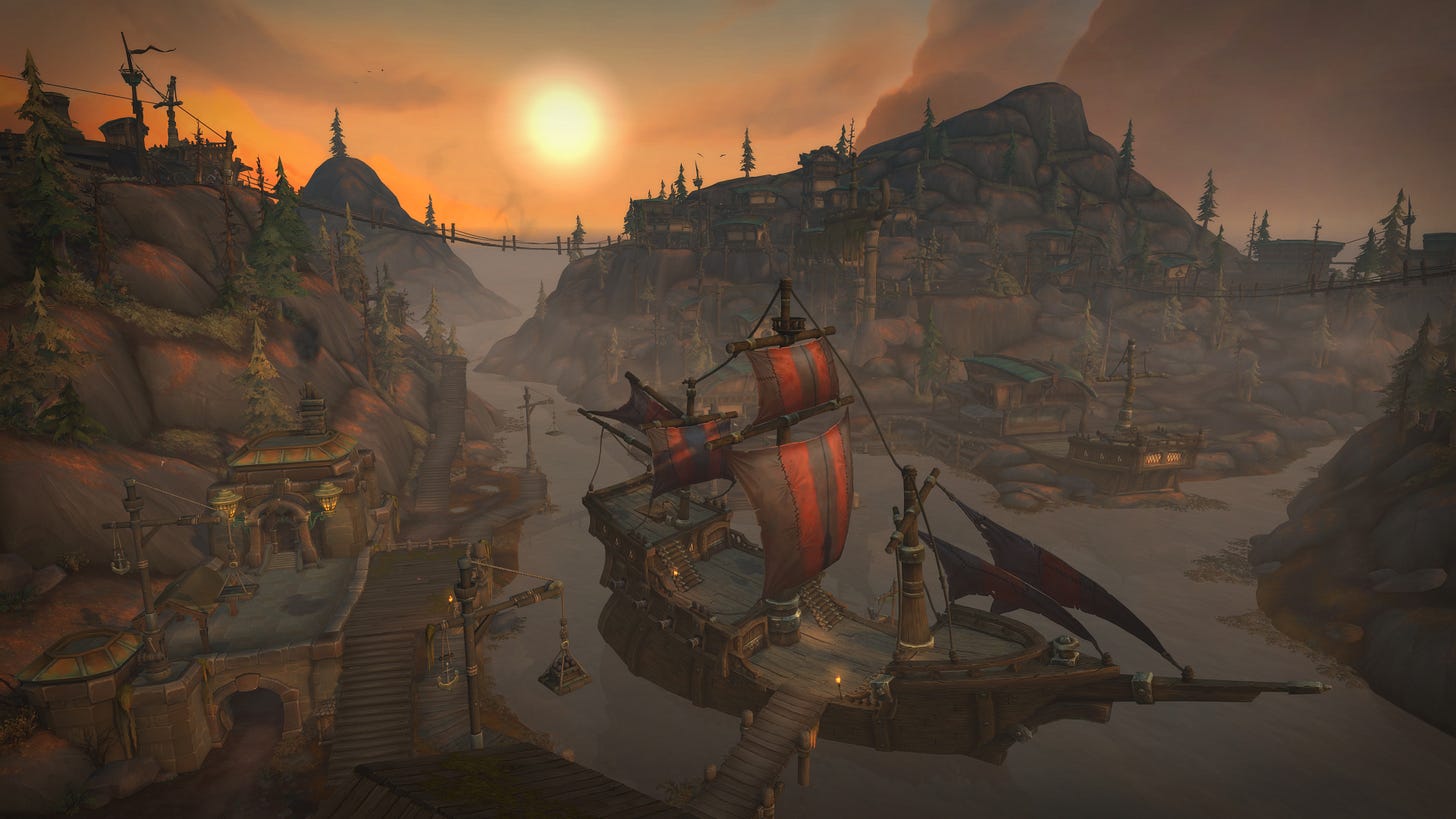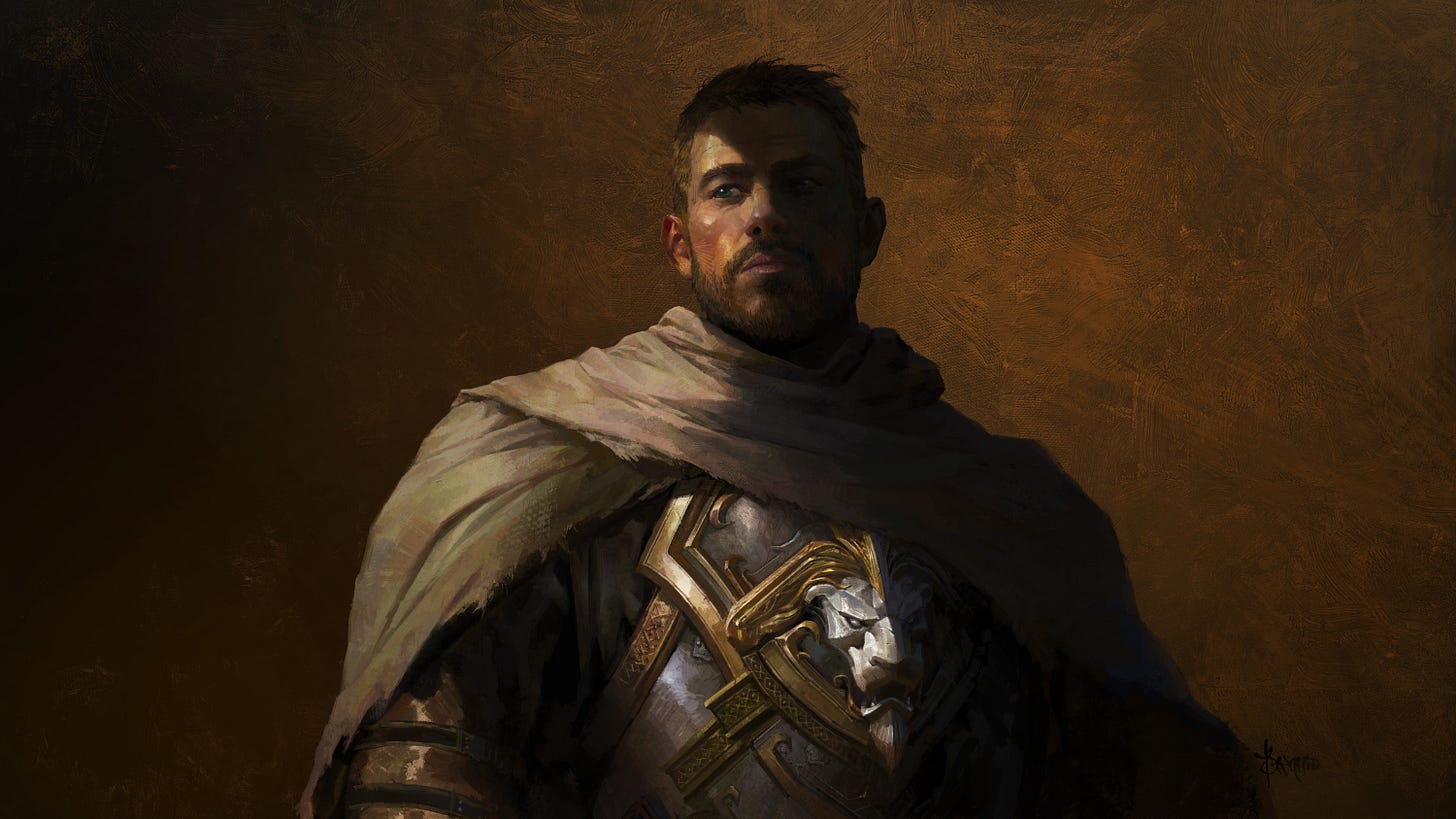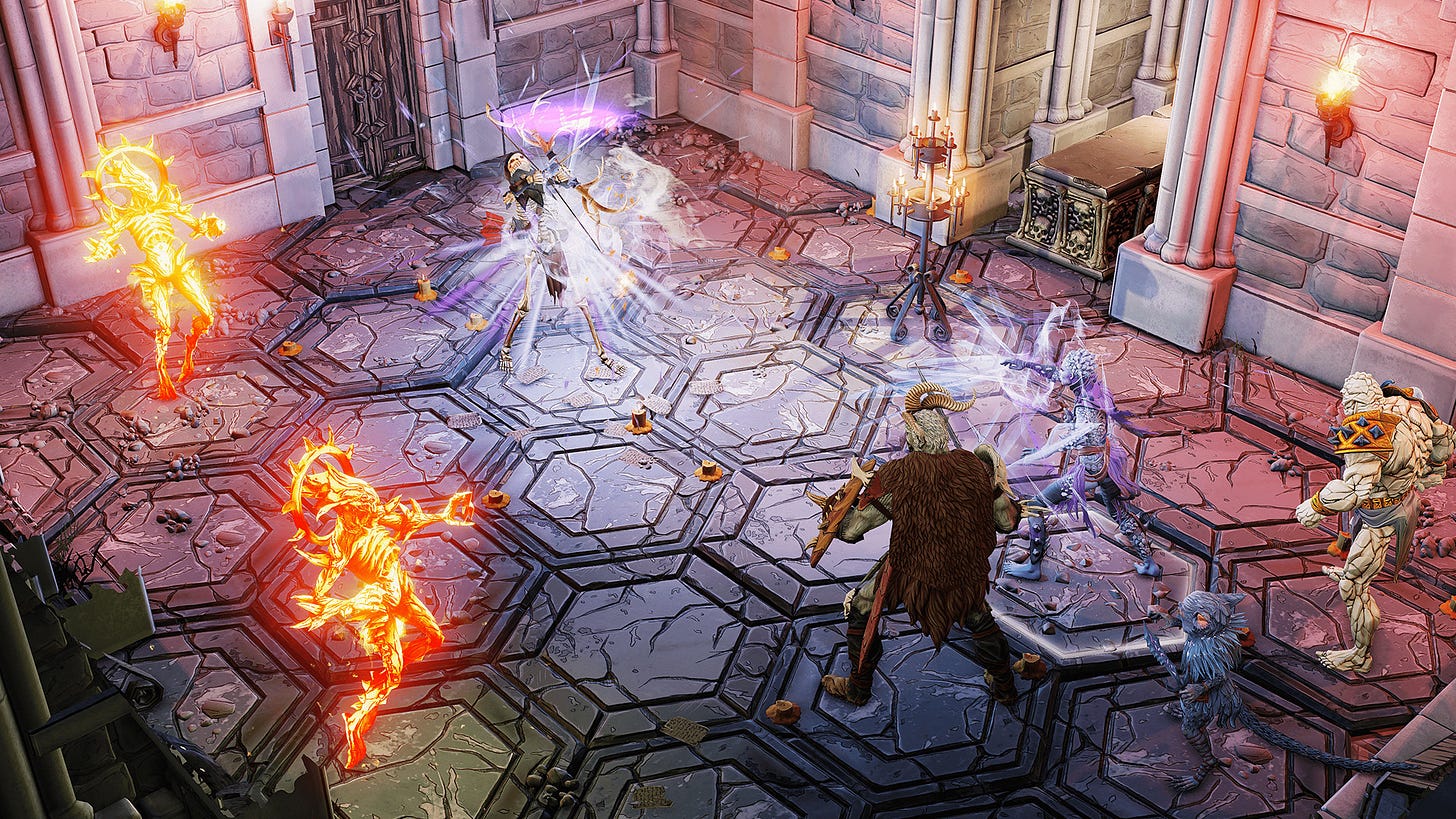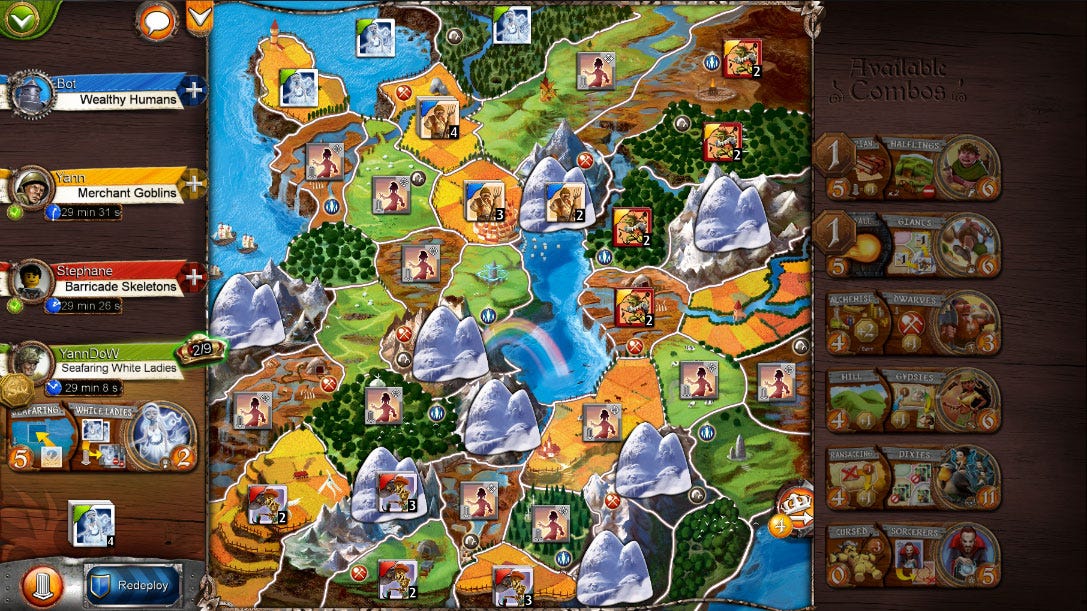What has Blizzard learned from 18 years of adding to Azeroth?
How a bestselling board game helped shape The War Within
My guests for this issue of Multiplier are Morgan Day and Ely Cannon.
Day is an associate game director of World of Warcraft while Cannon is a senior art director at Blizzard Entertainment. I spoke to the pair in the lead up to the recent Warcraft 30th Anniversary World Tour event in Sydney. Rather than exchange emails as I usually do, what follows is an abridged and edited write-up of the conversation that I had with Day and Ely.
Where last month saw me tweak the cadence of Multiplier, this issue is an experiment with the content side of the equation. Feel free to let me know what you think. Personally, I’m a little on-the-fence about it as the future of the newsletter. Still, it was fun to change things up and I hope you enjoy reading the piece that has come out of it.
Fergus: World of Warcraft has come a long way since Burning Crusade. By the time the expansion released in 2007, Blizzard’s breakthrough MMORPG was already a certified-megahit and the game has only grown bigger and more diverse in the 18 years since.
Where earlier expansions leaned into traditional fantasy locations like sleepy hamlets and spooky castles, the art team at Blizzard Entertainment quickly learned that they could be more adventurous. Later additions to Azeroth found plenty of mileage in putting a twist on those same tropes. When you’re working on anything for this long, you have to get creative.
Ely, It’s rare to talk with anyone in gaming who has worked on a single project on that kind of timescale. During your time at Blizzard, you've worked on fifty different zones. Do you have attachment to some more than others? Are there any you wish you could go back and change? Do you often have that opportunity?
Ely: Man, so many of the zones mark different times at Blizzard and on [World of Warcraft] too.
Going way back to Wrath of the Lich King, I have a lot of really good memories of those zones but specifically Icecrown Glacier was one of my favorite zones in that expansion. I got to work with one of my dear friends on it. We pioneered a lot of new techniques for creating WoW zones too.
One of which was creating modular terrain pieces for the first time where we could really build out extremely complex terrain shapes and do it based off of a kit of repeatable features. So you'd create a small piece of rock and then one that would go next to it and another one that would go next to it and then we could mix and match them up and like change them up as we pasted them in next to each other and it made the process possible to create the fidelity that we did for Wrath of the Lich King, which was really like a marker for WoW too.
Coming out of Burning Crusade, one of our primary goals was really to increase the fidelity of the world and see where we could take the world. Where could we take the art and the visual style of the game? Wrath of the Lich King was really the first trial in that space and I think Icecrown Citadel and Icecrown Glacier – specifically those areas – were probably the crowning jewel of that expansion as far as the techniques that we were employing then and just the art applied to the terrain.
It's one of the first times where we were really getting sharp forms into the mountains [and] really thinking about how snow would settle between ridge-lines and things like erosion effects on the terrain and all these types of philosophies and natural systems that we bring into game design now. They didn't exist in World of Warcraft up to that point. So it was kind of the first time we really started to think to that depth of execution in the world with the intention of creating fantastic spaces that had ability to them.
As humans we have this sort of natural understanding of the world around us that we might not consciously be aware of, but when it's missing in a fantasy space it's very difficult for a person to sort of step into it and believe it and and occupy that that fantasy world in the way that we want players to to do so.
Beyond that, I think Legion was another really awesome expansion to work on and got to work on some really fun zones, Stormheim specifically. That one I got to operate as a point. So for the first time [I was] really being involved with the quest team too and helping to guide the quest process as well as the world building process and be really involved with the art side of things as well to create what I think became a pretty iconic zone in the game.
Fergus: How long has that idea of world building been a pillar of how you're approaching the work? When I think about my memories of playing Burning Crusade and Wrath of the Lich King, so much of it is involves that visual spectacle and the larger than life look of the Warcraft universe. Was there a point where realism became more central to the worldbuilding process?
Ely: When we moved into the Wrath phase, it became more central [in] that we really started talking about the nature of a place along with just how it looked and having the look be informed by nature and even the people that live there.
I would jump forward to something like Kul Tiras [in Battle for Azeroth], for example. During the design of Kul Tiras, there was so much effort put into really thinking about how this marine-based society would have settled this new land that they came to and how each part of that culture would feed into that mariner industry and what role they would play alongside the others. You had the pig farmers, for example, and they're creating pigs and they're gathering pig manure and they also have a peat farm and that part of the culture was responsible for the gunpowder. Another part was the foundry and they were making the cannons. Another part was assembling the ships.
In the Drustvar space, that family and that part of the culture was actually guarding that pass. So in this culture, it was really important [that] they felt that they had been victims or that they were vulnerable in the past. So having that level of security built into how they are occupying the land told another part of their story that wasn't necessarily driven by quest narrative or anything, but really by a logic of how people, how cultures, how industries form a place and a people.
Morgan: Speaking of Kul Tiras, I always have similar vibes [from] a zone called Hallowfall. The Arathi are there and one of the things that we talked about really early on was [that] they're this sky-faring — less sea-faring — [faction] but they would integrate [that] and if they retire a ship, that ship would become like a major building in town.
We also talk a lot about timelines. If they've only been here for like 15 years, it wasn't a ton of time. So the team almost built concentric circles [around] the major city. They could have built this in 15 years, but the further you get away from that the more it's just like a lean-to. It's not like a real city that they would have had time to build. The team really looks at that level of detail to make sure that, you know, the kind of storytelling within the world is as big and important as a character as some of the narratives and the actual people that you might meet within that zone.
Fergus: That's fascinating. It almost reminds me of how a dense TTRPG sourcebook might lay out the broad strokes of a given place and then allow the natural facts of the world to flow from one location to the next.
Morgan: One of our main pillars on the team is that the world is the star. We really want to make sure that we're treating the world with the care that it demands and to make sure that the world is leading the way in terms of the storytelling and we're not shifting the world to be reactive.
It's very easy for your world to almost feel like Disneyland where there's like these spaces that are almost cartoonish in nature and they're on top of each other. It's just like bam, bam, bam. It's almost sensory overload versus [asking] how would this world have been 100 years ago and then how would people have approached settling this land? Let's make sure that's informing our decisions and informing the story of how we approach building the world and then telling the story within that space.
Fergus: On the other end of things, board games have become a bigger part of broader gaming culture over the past two decades. We’ve seen cardboard adaptations of major video games like Elden Ring and Horizon Zero Dawn break crowdfunding records and we’ve seen popular board games like Wingspan and Gloomhaven make the jump to digital. It’s entirely plausible that the overlap between the people who play both board and video games has never been larger so it’s only natural that those making games of either stripe are being influenced by one another.
Given that, it’s easy to wonder how – and which – board games might shape something as big and popular as World of Warcraft is. Morgan, are there any board games that have kind of changed the way you've thought about the work you do at Blizzard?
Morgan: I would say probably two that come to mind. One that is more just like a cultural gaming hook and another that I've been inspired by but never been able to execute an idea in World of Warcraft against.
But one would be Gloomhaven, obviously. It's great. We just finished Frosthaven but it just kind of speaks to the rogue-like or rogue-light nature of experiencing something and having some cool meta progression and then coming back in and just that idea we talk a lot about in World of Warcraft.
For so many years – actually, up until The War Within – we thought about your RPG experience as this is your experience with this character, right? Like, this is my warlock and we'll reward your warlock and then you might have to restart a progression with your Paladin or something like that. With The War Within, we really took a different philosophical approach that I think is almost inspired by games like Gloomhaven or roguelikes where it's like, no, no, no. Let's respect the time of the person behind the keyboard, right? Like you've done this progression already. Is it fun to do it a second time? And if not, why are we asking you to do that, right?
So we developed Warbands in The War Within to really make sure that we're respecting the time of the player and not just the character. Really it's about the cumulative experience in World of Warcraft that we really want to make sure we're considering and it's always, you know, incentivizing you to try different things that you might not have tried before.
And then another game which I love [is] Small World. So in Small World, the goal is basically [to] get gold. Every round you get gold and you draft a character that you play every turn and there's a prefix and a suffix, right? So like ‘crazy’ or ‘smart’ is your prefix and then [your suffix is] different nouns. Mammals like ‘ogre’, ‘Naga’. Stuff like that. They're randomly generated because you shuffle the deck and put them together.
Sometimes the synergies are really bad so nobody wants to pick it. But you just put a gold coin on that character every round it is not picked. So eventually it just becomes worthwhile to pick it because it's like, well, there's five gold on this thing and I'm only getting like nine gold [each] round anyways. This is halfway to my target. I can have a bad round but still feel rewarded for picking this. I've always thought that was a really elegant way to solve a problem that was created by a randomization system.
I've always enjoyed that and I've thought about that from the perspective of balance. Could you just buff a class procedurally until people start to invite it to groups? We would never do that, right? But it's just a fun design solution that I saw done in that game.
Fergus: Balance is such a sticking point for games as complex as World of Warcraft is, so it doesn’t shock me that the very different way that board games like Small World approach it has struck a chord with you.
I think it’s very easy to think about balance as a neutral force that makes all things equal and maybe even equally boring. To build on the musical metaphor, I try to think of it more like tuning an instrument to achieve a desired outcome or at the very least maximise the chances of that result occurring. There are some pretty big differences between World of Warcraft and Small World, but I do think there’s still plenty that the former can learn from the latter when it comes to thinking about stuff like balance.
That said, the turnaround time in board games is a little faster than the average World of Warcraft expansion pack. There’s been plenty of talk over the years about speeding up this process, what are the challenges that people don't see with that and why it may be more easily said than done?
Morgan: At the end of the day, we want to build the best experience and make sure we're building Blizzard quality experiences that reach that high quality bar that we have set for ourselves over the years. And something that I think that's really been a forcing function for us is to really look at and reflect on things that we might have done in the past and, frankly, almost do instinctively or out of habit, right?
Previous to I would say Shadowlands, it was really common for us to to, you know, just say or ask the question, well, how did we do that last time, right? And I think that can be a really dangerous place to find yourself in a creative industry with a team full of so many creative people because it can at times stifle creativity or start to build an experience that players almost are not surprised by or don't get as much delight out of as they could. So ultimately what that's really done is just have us ask a lot of questions of ourselves. Like, hey, is this actually something that we think players enjoy. How do we verify that? How do we really just question all of our previous assumptions and make sure that we're looking to make the best decisions to create the best experience that we can.
The community has changed, the game has changed. Things have evolved and it's really important to revisit some of those past decisions.







